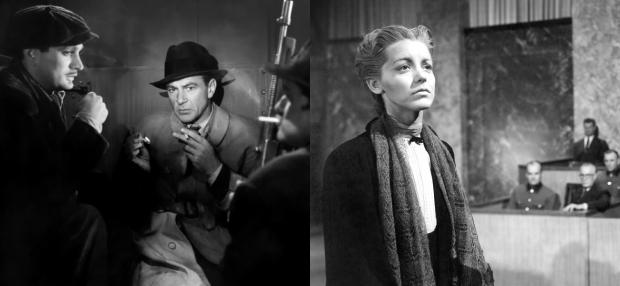Advertisement
Welcome. Tonight, we have a double bill of exciting World War II morale boosters. Both were written by members of the Hollywood Ten. Two-time Oscar-winner Ring Lardner, Jr. and two-
time Oscar nominee Albert Maltz co-wrote Cloak and Dagger. None Shall Escape was co-
written by Lester Cole, along with Alfred Neumann and Joseph Than. The latter were nominated
for a Best Writing, Original Story Oscar.
Cloak and Dagger is a good example of Hollywood’s Popular Front in action, uniting all anti-
fascists in a common cause. Not everybody in Tinseltown who was anti-Nazi was a member of
the Communist Party, like Lardner, Maltz and Cole had been. But Communist screenwriters
were often recruited to write anti-fascist screenplays because they were among La-La-Land’s
most politically conscious artists who were able to articulate what the cause was about. In terms
of productions, the Popular Front in Hollywood included anti-fascists like the Vienna-born
writer/director Fritz Lang, who had emerged as one of Germany’s top filmmakers. According to
legend, shortly after Hitler came to power, in 1933 Joseph Goebbels, the newly installed Minister
of the Reich Ministry of Public Enlightenment and Propaganda, summoned Lang to his office
where he told Lang that Der Fuhrer’s favorite movie was Metropolis. An international hit, this
sci fi epic was the 1927 equivalent to Avatar or Star Wars. Metropolis featured sharp class
warfare, but what Hitler especially liked was that the struggle between the hand – or labor – and
the brain – or capital – was mediated by the heart – not by proletarian revolution.
Goebbels offered Lang the job as head of the Third Reich’s film industry. Lang told Goebbels
he’d think the offer over and get back to the Reich Minister soon. Instead, legend has it that later
that day, Lang promptly got on a train and left Berlin.
Hitler may have been a fan of Metropolis, but Lang, of course, was no Nazi. In 1931 he tried to
warn Weimar Germany about the fascist threat with the movie that propelled Peter Lorre to
fame. In M, Peter Lorre played a tormented serial child killer. When he’s captured at the end by a
throng of angry parents, they demand to know why he has been killing their children and he
replies with one of the cinema’s most chilling four words: “I can’t help myself.” Anyway, Lang
was trying to warn Germans about the Nazis – that “the murderers are among us.”
Furthermore, Lang was reportedly part Jewish on his mother’s side. In addition, according to a
2001 New York Times article, Lang’s then lover, Lily Latte “was Jewish and left wing.”
Parenthetically, it’s worth noting that Goebbels failed miserably in his dream to make German
cinema the world’s best. A main reason why Goebbels failed is that the Nazis kicked all of the
Jews out of the film industry.
Some of them, like Lang, came to Hollywood where, among a number of film noir classics, Lang
shot several anti-Nazi pictures. In 1941 Lang helmed Man Hunt, about a near assassination of
Hiter in Bavaria. In 1943 Lang directed the anti-fascist drama Hangmen Also Die! set in
occupied Czechoslovakia, co-written by another refugee from the Nazis, the great German
playwright Bertolt Brecht. Lang’s 1944 Ministry of Fear was co-written by Graham Greene and
starred Ray Milland. Lang’s 1946 Cloak and Dagger is an atomic espionage drama written by
the Hollywood Ten’s Ring Lardner, Jr. and Albert Maltz.
Ring co-wrote 1943’s The Cross of Lorraine about the French Resistance, co-starring Gene
Kelly. Ring also co-wrote 1944’s Tomorrow, the World! about the mythos of Aryan superiority.
Ring struck Oscar gold with 1942’s Woman of the Year and 1970’s M*A*S*H.
Maltz wrote English narration for the 1942 Soviet documentary Moscow Strikes Back and 1943’s
Seeds of Freedom, which combined new footage of Odessa anti-Nazi guerrillas with scenes from
Sergei Eisenstein’s masterpiece Potemkin. The other patriotic WWII movies Maltz wrote were
1943’s Destination Tokyo, with Cary Grant and John Garfield. The latter also starred in 1945’s
Pride of the Marines, co-written by Maltz, who was Oscar-nominated for his script, as he was for
1950’s Broken Arrow. On the home front, Maltz co-won an honorary Oscar for writing the anti-
bigotry short The House I Live In, starring Frank Sinatra in 1946 – a year before Maltz was
blacklisted.
After we watch Cloak and Dagger we’ll be joined by documentarian Roger Memos to discuss
Marsha Hunt and then screen None Shall Escape, in what may be Marsha’s greatest role and the
most powerful studio movie made during WWII about Jewish resistance to the Nazis. BTW,
Marsha Hunt is especially beloved by blacklistees because even though she was never a
Communist Party member herself, Marsha refused to become an informer, despite the fact that
her career suffered during the Hollywood Blacklist.
Schedule info for the remaining screenings of The Hollywood Ten at 75 film series at the
Academy Museum of Motion Pictures:
Objective, Burma! 2:00 p.m. Sunday, April 23, introduction by Ed Rampell.
John Garfield double feature Force of Evil and He Ran All the Way 7:30 p.m., Thursday, April
27, introduction by K.J. Relth-Miller, Interim Director, Film Programs, Academy Museum of
Motion Pictures.
Spartacus 7:30 p.m., Saturday, April 29, introduction by Ed Rampell and Dalton Trumbo’s
daughter-in-law, Nancy Escher.
Salt of the Earth 2:00 p.m. Sunday, April 30, introduction by Ed Rampell, followed by a panel
discussion featuring Eve Bodenstedt, granddaughter of Salt’s star Rosaura Revueltas, who is
flying up from Mexico for the event; co-star Will Geer’s daughter and granddaughter, Ellen Geer
and Willow Geer; and Bill Jarrico, son of Salt’s producer Paul Jarrico.
For details see:
https://www.academymuseum.org/en/programs/series/the-hollywood-ten-at-75
(Note: This is the edited text for the introduction to the April 14 screening of Cloak and Dagger
by Ed Rampell and to None Shall Escape by Roger Memos, the director and co-writer of the
2015 documentary Marsha Hunt’s Sweet Adversity, at the Academy Museum for this series
commemorating the 75 th anniversary of the Hollywood Blacklist.)

